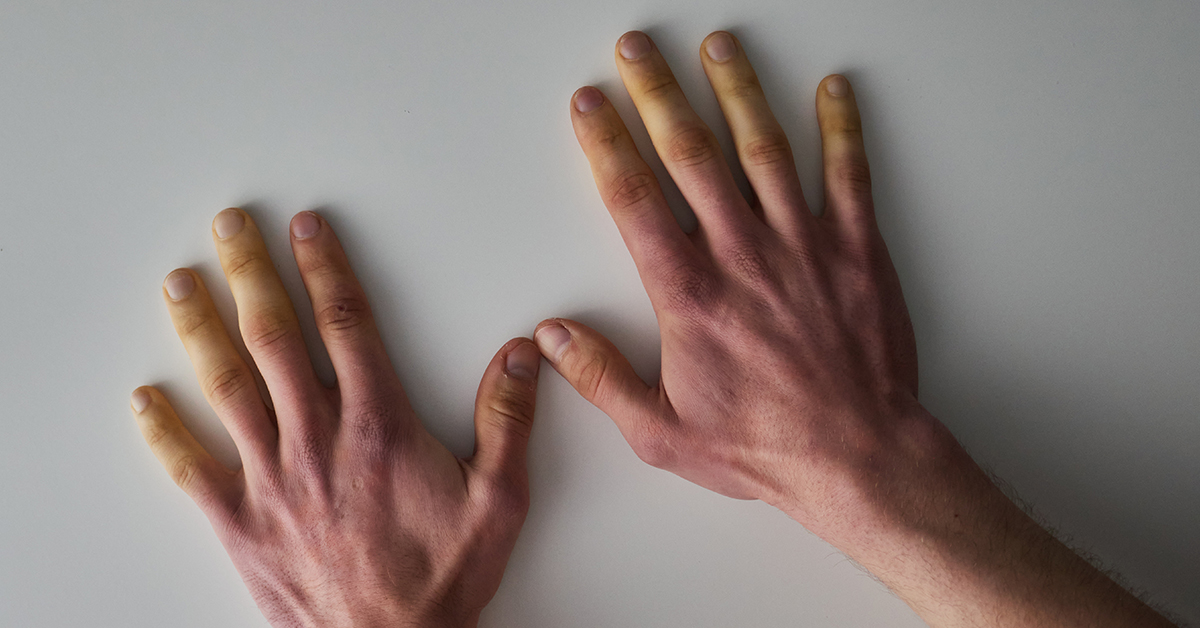

COURTESY PHOTO
Hands with Scleroderma.
Scleroderma is a chronic autoimmune disorder that replaces your body’s healthy connective tissue with thick, hard tissue that’s full of extra collagen, a protein that serves as a building block for connective tissue. Connective tissue is fibrous tissue that supports, protects or gives structure to other tissues and organs in the body.
Scleroderma is an unpredictable disease. Sometimes, it’s mild and affects only your skin, which is made up of connective tissue. But other times, scleroderma involves multiple organs and can be potentially fatal. The disease varies from person to person, but up to one in three people with the condition develops severe symptoms.
Fortunately, scleroderma is rare. Fewer than 500,000 people in the United States have it. It is more common in women than in men. It’s estimated that six out of seven people with scleroderma are women. It most often develops in people between 35 and 50 years old, but it can affect young children and older adults as well.
Normally, your body’s immune system battles disease and infection by releasing germ-killing chemicals and cells and by triggering disease-fighting processes. With an autoimmune disorder, your immune system mistakes your body’s own cells and tissues as foreign invaders and initiates the process to destroy them.
If you have scleroderma, your immune system triggers your protein-producing cells to make too much collagen. The extra collagen builds up in your skin and internal organs, causing them to become thick and hard. In this condition, your organs can’t function properly and symptoms appear.
One of the first symptoms of scleroderma is thickening of your skin, primarily on your fingers and hands. Swelling of your hands and feet and red spots on your skin may also develop. Other symptoms may appear if additional organs become involved. These include joint pain and stiffness, persistent cough, shortness of breath, heartburn and other gastrointestinal issues, difficulty swallowing, high blood pressure, constipation, weight loss and fatigue.
There are two main forms of scleroderma: localized and systemic. Localized scleroderma, the milder form, primarily affects your skin, but it may also affect your muscles and bones. There are two main types of localized scleroderma, morphea and linear. They differ mainly in the appearance of the thickened patches of skin and the areas affected.
Systemic scleroderma affects the entire body. This includes the blood vessels and internal organs, especially the kidneys, esophagus, heart and lungs. There are two main types of systemic scleroderma. They are limited, sometimes referred to as CREST syndrome, and diffuse.
Limited scleroderma primarily affects the skin on the hands, feet, face, and lower arms and legs, but may also affect the blood vessels, lungs and digestive systems. One of the main symptoms of CREST syndrome is Raynaud’s phenomenon, color changes in the fingers and sometimes toes after exposure to cold temperatures. Raynaud’s occurs when blood flow to these areas is temporarily reduced.


COURTESY PHOTO
Fingers experiencing Raynaud’s phenomenon
Raynaud’s phenomenon is a common symptom of scleroderma. More than 90 percent of patients with scleroderma have Raynaud’s. But you can have Raynaud’s and not have scleroderma.
People with diffuse scleroderma, the more serious type, typically have skin thickening in the area from the hands to above the wrists. The diffuse type can affect many internal organs as well, hindering digestive and respiratory function, and causing kidney failure. It can become serious and sometimes life-threatening.
The cause of scleroderma is unknown. Researchers believe there are genetic and environmental factors involved in its development, but these theories have not been proven. It is known that scleroderma is not contagious.
Diagnosing scleroderma can be challenging because its symptoms are similar to those of other autoimmune diseases. Diagnosis generally requires consultation with rheumatologists and/or dermatologists. Blood tests and a variety of other specialized diagnostic exams are used depending on which organs are affected.
Currently, there is no cure for scleroderma. Treatment for the condition is aimed at controlling and managing symptoms, minimizing damage and maintaining function. The approach used is typically a combination of medication and self-care. Physical therapy may be recommended to keep your muscles and joints functioning at their best.
Scleroderma can affect many areas of your body, so living with the disease can be quite challenging. It may result in physical limitations and pain, but there are a few things you can do to improve your situation and make your life a little more comfortable. Consider the following tips:
- If you experience digestive issues, eat multiple small meals throughout the day instead of three large meals.
- Keep your skin well-moisturized to lessen stiffness.
- Be careful during activities such as gardening and cooking so that you don’t injure your fingers.
- Dress in layers to keep your body warm. Wear socks, boots and gloves, and avoid very cold environments.
- Exercise to ease the stiffness in your joints. Ask your physical therapist for safe exercises.
- Maintain relationships with your family and friends to create an emotional support system.
- Seek professional help if you struggle with the psychological consequences of living with a chronic disease.




Leave a Reply